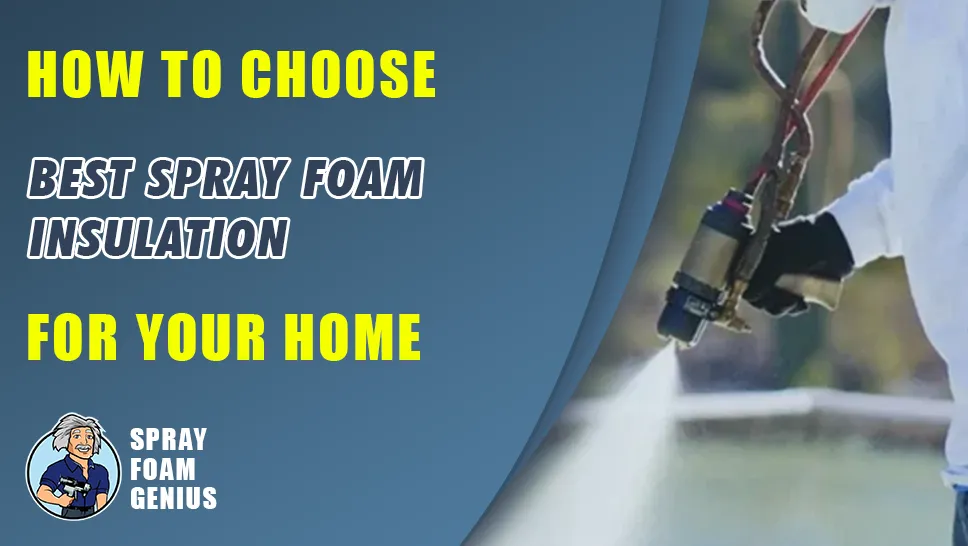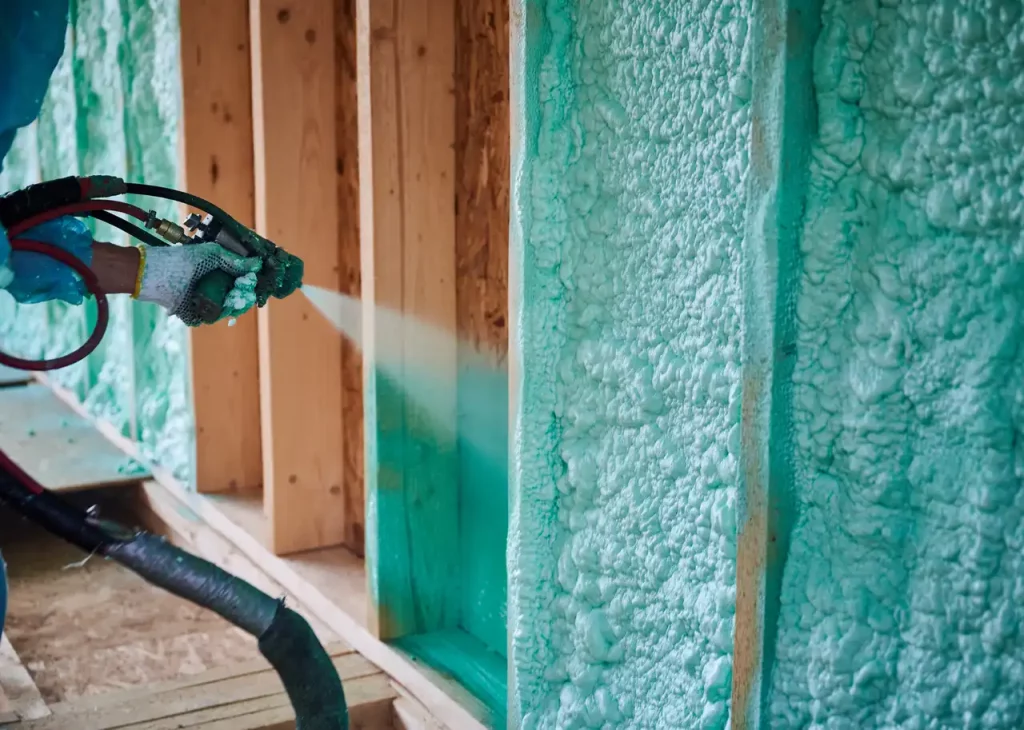
Spray foam insulation is one of the most effective solutions for maintaining a comfortable temperature in your home while saving on energy costs. However, with various options available in the market, choosing the best spray foam insulation for your home can be challenging. This guide is designed to help you make an informed decision, ensuring you select the ideal insulation for your specific needs.
Why Spray Foam Insulation?
Spray foam insulation is renowned for its superior insulating properties, effectively sealing gaps and cracks that other insulation types might miss. It not only prevents air leakage but also acts as a barrier against moisture, which can lead to mold growth and other structural issues. Whether you’re building a new home or retrofitting an existing one, spray foam insulation can significantly enhance energy efficiency and indoor comfort.
Understanding the Types of Spray Foam Insulation

Before diving into the selection process, it’s crucial to understand the different types of spray foam insulation available. The two primary types are:
1. Open-Cell Spray Foam Insulation
Open-cell spray foam is less dense, making it softer and more flexible. It has a lower R-value (a measure of insulation’s effectiveness) compared to closed-cell spray foam, typically around 3.5 to 3.6 per inch. However, its open-cell structure allows it to expand significantly after application, making it ideal for hard-to-reach areas. It’s also more affordable and provides excellent soundproofing qualities.
When to Choose Open-Cell Spray Foam:
- Ideal for interior walls, attics, and ceilings.
- Best for areas where soundproofing is a priority.
- Suitable for homes in milder climates.
2. Closed-Cell Spray Foam Insulation
Closed-cell spray foam is denser and more rigid, with an R-value ranging from 6 to 7 per inch. Its structure makes it highly resistant to moisture, providing a strong barrier against air and water infiltration. Closed-cell spray foam also adds structural strength to your home, making it a preferred choice for exterior walls and roofs.
When to Choose Closed-Cell Spray Foam:
- Ideal for exterior walls, foundations, and roofs.
- Best for areas prone to moisture or in regions with extreme temperatures.
- Suitable for homes requiring additional structural support.
Key Factors to Consider When Choosing Spray Foam Insulation
Selecting the best spray foam insulation involves considering several factors, including climate, budget, and specific areas of your home that need insulation. Here’s a closer look at these considerations:
1. Climate
Your home’s climate plays a significant role in determining the type of spray foam insulation you need. In colder regions, closed-cell spray foam’s higher R-value is more effective in keeping the cold out and retaining warmth. Conversely, open-cell spray foam may be sufficient for homes in milder climates, where extreme temperature fluctuations are less common.
2. Budget
While spray foam insulation is an investment that pays off in energy savings, the initial cost can vary. Open-cell spray foam is generally less expensive, making it an attractive option for budget-conscious homeowners. However, if you live in an area prone to extreme weather or moisture, the additional cost of closed-cell spray foam may be worth the investment for its durability and efficiency.
3. Application Area
Different areas of your home may require different types of insulation. For example, open-cell spray foam is ideal for interior applications, such as walls and ceilings, due to its soundproofing qualities and ability to fill irregular spaces. Closed-cell spray foam, with its superior moisture resistance and structural reinforcement properties, is better suited for exterior walls, foundations, and roofs.
The Installation Process: What to Expect
Understanding the installation process can help you prepare your home and set realistic expectations. Spray foam insulation should always be installed by a professional to ensure optimal performance and safety.
1. Assessment
A professional insulation contractor will first assess your home to determine the specific areas that need insulation and the type of spray foam that will be most effective. This assessment may include checking for air leaks, moisture issues, and existing insulation quality.
2. Preparation
Before applying the spray foam, the contractor will prepare the area by cleaning and drying the surfaces to ensure proper adhesion. In some cases, old insulation may need to be removed.
3. Application
During application, the spray foam is mixed on-site and sprayed onto the surfaces where it expands and hardens. The foam creates a seamless barrier that effectively seals gaps and cracks, providing superior insulation.
4. Curing and Inspection
After the foam is applied, it needs time to cure, which can take a few hours to a day, depending on the type of foam used. Once cured, the contractor will inspect the installation to ensure it meets the required standards and addresses any areas that may need additional coverage.
Benefits of Professional Installation
While some homeowners may consider DIY spray foam insulation kits, professional installation is highly recommended. A certified contractor has the expertise to apply the foam correctly, ensuring it provides maximum insulation and adheres to safety standards. Additionally, professional installation typically comes with a warranty, giving you peace of mind and protection against potential issues.
Common Mistakes to Avoid When Choosing Spray Foam Insulation
Making the right choice for your home’s insulation requires avoiding common pitfalls. Here are some mistakes to watch out for:
1. Ignoring Climate Considerations
Failing to consider your local climate can result in choosing the wrong type of spray foam, leading to suboptimal performance and higher energy costs. Always select insulation that matches the temperature and humidity conditions of your area.
2. Overlooking the Importance of R-Value
The R-value is a critical factor in determining the effectiveness of insulation. Choosing a foam with an insufficient R-value for your region’s climate can compromise your home’s energy efficiency.
3. Cutting Costs on Installation
Opting for the cheapest installation option may save money upfront but can lead to problems down the road. Poor installation can cause gaps, voids, and other issues that diminish the insulation’s effectiveness. Invest in a reputable contractor to ensure the job is done right.
The Environmental Impact of Spray Foam Insulation
Sustainability is an important consideration for many homeowners. While spray foam insulation is effective in reducing energy consumption, it’s also essential to consider its environmental impact.
1. Energy Savings
One of the most significant environmental benefits of spray foam insulation is the energy savings it provides. By reducing the amount of energy needed to heat and cool your home, you can lower your carbon footprint and contribute to environmental sustainability.
2. Material Composition
Closed-cell spray foam is typically made from a blend of chemicals that can have environmental impacts if not managed properly. However, advancements in technology have led to the development of more eco-friendly options, such as spray foam made from renewable resources or with reduced chemical emissions.
3. Longevity
Spray foam insulation’s durability means it doesn’t need to be replaced as often as other types of insulation, reducing waste and the need for new materials. This long-term efficiency makes it a more sustainable option overall.
How to Find a Reputable Spray Foam Insulation Contractor
Choosing the right contractor is just as important as choosing the right insulation. Here are some tips to help you find a reputable spray foam insulation contractor:
1. Research and Reviews
Start by researching local contractors who specialize in spray foam insulation. Look for online reviews and ratings to gauge customer satisfaction and the quality of their work.
2. Certifications and Experience
Ensure the contractor is certified and has experience in installing spray foam insulation. A well-established contractor with a solid track record is more likely to provide reliable and high-quality service.
3. Get Multiple Quotes
Obtain quotes from several contractors to compare prices and services. Be wary of significantly low quotes, as they may indicate subpar materials or workmanship.
4. Ask for References
A reputable contractor should be able to provide references from previous clients. Contact these references to ask about their experience and satisfaction with the work performed.
Secure Your Home’s Comfort and Efficiency Today!
Choosing the best spray foam insulation for your home is a critical decision that will impact your comfort, energy savings, and overall home value. By understanding the different types of spray foam, considering your specific needs, and working with a trusted contractor, you can ensure your home is well-insulated and protected against the elements.
Ready to enhance your home’s insulation and start saving on energy bills? Contact Spray Foam Genius Marketing today! Our expert team is here to guide you through the entire process, from selecting the right insulation to professional installation.
Call us at 877-840-FOAM for USA and 844-741-FOAM for Canada visit our website at sprayfoamgeniusmarketing.com, or email us at [email protected] to get started.
- Social Media Marketing for Spray Foam Businesses: What Works in 2025? - February 6, 2025
- Best SEO Strategies for Spray Foam Insulation Contractors to Rank #1 on Google - February 6, 2025
- What is Spray Foam Insulation? Benefits and Applications - February 5, 2025

